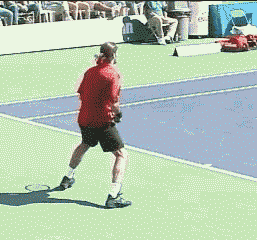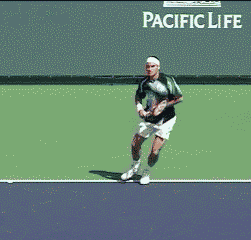|
TennisOne Lessons Dominating the Backhand Diagonal Game-Based Situation Training Wayne Elderton Situation Training is a practical application of the international coaching trend called the Game-based approach. Situation Training equips players with the tactics and techniques required for successful play.
In our last installment (Dominating the forehand diagonal), we looked at the keys to a dominating forehand crosscourt exchange. This article will add to those concepts and apply them to the backhand diagonal. The Story You're a 3.5-5.0 level player. You have pulled your opponent into a backhand crosscourt exchange. Overall, you are both pretty equal. You feel that if you can notch it up a bit they will crack. What can you do? How can you pressure them more? A solid backhand exchange is a required skill for effective tennis. Especially when playing against today's typical, ‘big serve/big forehand' players. Many players are weaker on the backhand side. With a little bit of work, you can be dominating by constructing points from a backhand crosscourt exchange. In clip #1, we see Andy Roddick (near side) against Guillermo Coria. We will look at the combination of shots they use to gain advantage over each other. This is a great example of how to construct a baseline exchange on the backhand. Run the clip a few times and see if you can identify the main tactical shots they employ? Tactics for the Backhand Exchange To dominate the backhand crosscourt exchange, there are three key shots to use:
#1: A Backhand Crosscourt “Pin”: A good crosscourt allows you the highest percentage of consistency (there is more court space diagonally across the court). It also challenges your opponent by keeping them to one side, and gives you the easiest recovery. The foundational shot is the crosscourt “pin”. A pin is a shot strong enough that if your opponent tries a down-the-line or sharp angle, they will have to risk (they will loose more than they get). For a more specific definition and examples see the previous article (Dominating the forehand Diagonal). #2: A ‘Mix-up' Backhand Slice: Throwing in a slice can throw your opponent off by changing the speed, spin, and trajectory of the ball. This forces them to modify their stroke. If they don't adapt well enough, the next ball they send will be weaker than usual. #3: A “Run-around” Forehand: In a backhand to backhand exchange, there is an extra advantage you can employ. For many players, their forehand can put more pressure on an opponent than their backhand. When you have a chance, run around your backhand and use your forehand. Matching your strong forehand to their backhand will add pressure and crack their backhand diagonal. The result will be a weaker shot you can take advantage of.
This isn't a new revelation. This tactic has been around for a while. The key reason players don't take advantage of it is that it requires a higher degree of decision-making. Let's walk through the key decisions and make it easier to implement. The first decision is when to run around the shot? If the shot your opponent sends doesn't pin you, that's the time to run around. The “Decision Trigger” that tells you there is enough time to run-around is when you receive a ball with the following characteristics:
Remember, you are somewhat out of position once you hit the run-around forehand. If all you can hit is a forehand that is only as tough as your regular backhand, don't take the risk. Only run-around if you can pressure your opponent more. The shot must be strong enough to make it risky for your opponent to go down-the-line to your forehand. Once you have decided to run around your backhand, there are two key shot selections you can make (see diagram). Inside-out and Inside-in. (all references are for right-handers
Decision trigger: You can pick this shot whether you are deep or short on the baseline. If you are deep, this shot is preferred over the inside-in since it is easier to connect with the ball beside you and send it to your opponent's backhand when you move back and around.
Decision-trigger: An Inside-in becomes a high percentage option when the ball is shorter and you can be on the baseline or inside the court. (Note: You can also hit good inside-outs from this position, which makes your inside-in even more of a surprise tactic). Here is our shot Situation Chart for the run-around forehand:
Go back up to the top of the article and review the first clip with your new-found understanding of the, “Dominate the Backhand Diagonal” tactics. Take note of the combination of Pins, Mix it up slices, and run-around forehand inside-outs and inside-in.
Drilling This is a baseline game (no coming to net). Start with both players in their respective backhand corners (don't start in the middle of the court). The point starts with a rally backhand to backhand. One player is designated the, “Rallier” and is only allowed to hit backhands (they can slice or pin). The other is the “Dominator” and can, if any shot is weak, run around and do a forehand inside-out or inside-in. Scoring: The Dominator starts at 3 points, the Rallier starts at 5. Making an error subtracts a point from your score. Winning adds a point. The Dominator gets a bonus point (2 points total) if they win by using their forehand. First player to 10 wins the game then, switch roles. Your comments are welcome. Let us know what you think about Wayne Elderton's article by emailing us here at TennisOne.
|
|||||||||||||||||||||||||||||



 )
) Wayne Elderton
Wayne Elderton